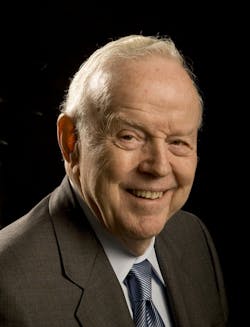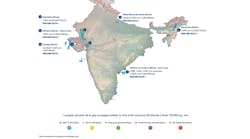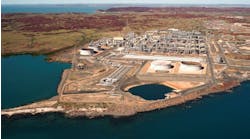Diego Lamacchia, Leviticus Subsea
When R.J. Brown (or “Bob,” as many knew him), passed away in late January 2018, the offshore industry noted the loss of one its leading marine pipeline engineers. During his distinguished six-decade career as a marine pipeline engineer, Brown was known for innovations that made marine pipelining more efficient and much safer.
As a result, he was recognized with a number of awards, including the Heritage Award presented at the 1997 Offshore Technology Conference, and the 2010 ASME Global Pipeline Award. In 2008, he was inducted into the Offshore Energy Center’s Hall of Fame. Less noted but no less important was the impact that Brown had on the development of the international subsea engineering and marine construction marketplace.
Getting started
The discipline of offshore pipeline engineering, and later subsea engineering, started in the mid-1960s when Brown, who at that time was working with George Hinkle in Bechtel, was sent to Holland to open the engineering office in The Hague and look for work in the submarine pipeline business. Hinkle was sent to the Paris office. Brown and Hinkle knew each other from working at Collins Construction Co. (a firm that specialized in subsea pipeline construction and crossings) in the early 1960s.
By the late 1960s, the North Sea had become a profitable place to search for oil and gas. Offshore construction companies (what we know today as EPCI contractors) such as Brown & Root, McDermott, and Heerema led the way, and adjusted their operations to the harsh and demanding working conditions of the North Sea. Operators were usually at the contractor’s mercy for these risky and costly offshore projects, and this provided the right conditions for independent consultants to offer engineering and project management services.
From 1966 to 1968, both Brown and Hinkle worked for Bechtel in the North Sea, a place where offshore construction companies dictated the way projects were done. A downturn in the US led Bechtel to pull work from The Hague office, leaving a minimum amount of work for both Brown and Hinkle. Then, a Dutch dredging company (IHC Holland) had a request from the Russians (at that time USSR) to develop a vessel to install pipelines in the Caspian Sea, and asked them for help. This opportunity emboldened the two men to start their own company (in addition, Bechtel, a US company, was somewhat reluctant to deal with the Russians).
In 1969, Brown and Hinkle, along with John Burns, opened their own submarine pipeline engineering and project management firm named R.J. Brown and Associates (RJBA). John Burns, who oversaw the Houston office, later decided to sell his share and continue working at RJBA as a consultant engineer.
In 1971, IHC built the Suleyman Vezirov, a shallow-water pipelaying barge for the Russians, with RJBA performing the engineering and construction management. The barge was built in two pieces, transported to the Caspian Sea via the Volga river, and reassembled in 1973 when they got there. The Suleyman Vezirov is still in operation and is owned by ASCO (Azerbajijan Caspian Shipping Co.), based in Baku.
RJBA went on to perform submarine pipeline design projects all over the world, including the first subsea pipeline in the Arctic (even though it was a test line); the design of the first semisubmersible third-generation laybarge (3GLB); and several pipeline crossings and shore approaches, such as the Strait of Magellan crossing in 1978. They specialized in plough design to trench pipelines and pipeline bundles installed by the tow-lay method. Due in part to this initial work with the Russians, the 3GLB Viking Piper was built in 1973 by Gusto Shipyard (another IHC Holland subsidiary). The Viking Piper changed names over the years as it was bought and sold by different owners. It was McDermott’s LB200, then the Acergy Piper, and then Saipem’s Castoro 7. It was considered one of the most efficient assets in the market for more than 41 years, until the barge was scrapped in July 2016.
Brown and Hinkle parted ways in the early 1980s, with Brown buying 100% of Hinkle’s shares. In 1991, RBJA became Kvaerner R.J. Brown; and in 1996 it became R.J. Brown Deepwater with Aker Kvaerner. Aker was bought by Coeflexip/Stena in 1998, and Technip absorbed all the Aker legacy companies including RJBD and Genesis Oil and Gas Consultants in 2001. Technip consolidated all its branches in 2003 and R.J. Brown Deepwater became part of the Technip group. In 2011, Technip consolidated all its offshore/subsea engineering groups under Genesis. Brown worked with Genesis and handled the model room until the day he passed.
Brown’s “model room” was a state-of-the-art facility for physical modeling. The Thunder Horse model included the semisubmersible production facility called Production, Drilling & Quarters (PDQ). The model included all the subsea infrastructure, including steel catenary risers (SCRs), subsea structures and flowlines, the flowline installation vessel Deep Blue and a semisubmersible drilling rig, all in scale at 1:70. BP indicated that “the model provided an unusually effective vehicle for analysis and procedure development, as well as for training and visual demonstrations.”The early days
While R.J. Brown & Associates started basically as an offshore pipeline design engineering firm. There were two other engineering firms in Europe that were at that time the cream of the offshore engineering market: Doris Engineering and Gusto Engineering.
Doris Engineering was originally formed back in 1965, but it was in 1971 that it started providing engineering services for the offshore industry, specifically for offshore structures. Doris was known for structural engineering for fixed platforms and gravity-based platforms in the 70s and 80s. The same was true for Gusto Engineering. Marine Structure Consultants (MSC) was formed with former Gusto employees in 1977. In 2003, both companies (MSC and Gusto) merged and formed GustoMCS.
In the 1970s, RJBA was a pioneering engineering consulting firm that specialized in submarine pipelines. It enjoyed great success, with up to 1,000 employees worldwide, and offices all around the world. The most recognized submarine “pipeliners” in the industry worked for RJBA. They included: John Burns, Jose Gonzalez Jauregui, Gene Mullee, Bill Timmermans, Ravi Perera, Hans Lagerwaard, John Bomba, John Patrick Kenny, A.H Mouselli, Andrew Palmer, Tuncer Akten, Ibrahim Konuk, David McKehaan, Jayesh Antani, Gene Raborn, Glen Lanan, Joe Straub, Upali Panapitiya, Jacob Chakco, Joe Straub, Wafic Ayoub, Franz Koop, Vural Dolen, and Steve Hindmarsh – just to name some of the professionals that this author remembers.
In the late 70s and early 80s, some of these engineers, who had worked for R.J. Brown, decided to open their own business. They went on to become icons in the industry:
• John Patrick Kenny opened his own company in the UK in 1978 (with lifetime partner Paul Davis) when R.J. Brown decided to close its London office. He named his company JP Kenny & Associates (JPK), a consulting engineering firm that became a leader in subsea pipeline design.
• Andrew Palmer joined R.J. Brown and Associates, as the leading consultant in underwater pipelines, in 1975. He worked on underwater plows, ice mechanics, and new techniques for Arctic pipeline construction. He was the project manager for the “actual” first Arctic offshore pipeline, built off the coast of Melville Island in Canada. In 1985, Palmer founded Andrew Palmer & Associates, a UK company of consulting engineers who specialized in marine pipelines, and who collectively had been engaged in pipeline projects on every continent.
• William (Bill) Timmermans formed INTEC Engineering in 1983 with three other R.J. Brown employees – Bert Schultz, David McKehaan, and Jim Gillespie. INTEC was a Houston-based company that specialized in subsea pipelines and marine terminals. Timmermans was the design engineer for the Suleyman Vezirov vessel project.
• John Stanfield, John Dryer and John Hines, the three “Johns” (all three ex-RJBA), formed Mentor Engineering in 1987, which specialized in subsea pipelines and structures.
• John Wilson and Joe Litzelfelner formed Pegasus International in US in 1981, a firm that specialized in offshore engineering and project management.
If in the 1970s the offshore engineering was led by Doris and Gusto, in the 80s more consulting engineering firms were formed in England with additional specialties all related to subsea engineering, and incorporated more processing (the early flow assurance systems), and subsea systems and controls. These firms included:
• Granherne, founded in 1984, was a consulting engineering firm that specialized in onshore, offshore and deepwater oil and gas developments.
• Mentor Subsea was formed in 1987 to include not only submarine pipelines but also subsea systems engineering. Mentor had four founding members, all coming from the Vickers Industries (a naval construction yard that did most of UK submarines in the WWII): Tony Cousins, David Pridden, Bob Charters and Graham Day. Mentor engineered the subsea system for BP’s Foinaven development, which was the UK’s first deepwater project in the early 90s. Mentor Subsea was different from Mentor Engineering even though they were in the same office building in the town of West Byfleet near London.
• Genesis Oil and Gas consulting was formed in 1988 with Chris Harding and John Cambridge (who also worked as contractors for RJBA in London). It was originally a process engineering company providing consultancy services to the offshore and subsea industry.
Moving into deepwater
As operators moved into deepwater (greater than 300 m), the industry began to develop new subsea systems for areas where saturation diving was not possible. Starting in the 90s, the industry began to develop floating production systems and dynamic riser systems for water depths greater than 400 m. The discipline of flow assurance, which allowed engineers to better understand the multiphase flow coming from the reservoirs, was born from a Petrobras initiative in the 1990s. The Blue Stream pipeline, the first pipeline designed for 2,000-m water depths, was installed in the early 2000s.
Subsea engineering firms continued to evolve in this decade, with bigger players acquiring the smaller firms. Kvaerner bought RJBA in 1991; Penspen acquired Andrew Palmer and Associates in 1993; and Wood Group bought JP Kenny and Associates in 1993. Later in 2000, Wood Group acquired Alliance Engineering; and in 2001 Pegasus International bought Mentor Engineering.
Also in the 90s, engineering, procurement, construction, and installation (EPCI) companies tried to increase their offerings by acquiring subsea/offshore engineering firms, and allowing them to carry lump-sum turnkey subsea development megaprojects. The main buyouts were:
• McDermott with Mentor Subsea
• Heerema with INTEC Engineering
• Technip with R.J. Brown Deepwater, Aker Engineering (including Genesis)
• Halliburton with KBR (mostly FPSOs).
The last one deserves a special mention. Halliburton acquired Dresser Industries in 1998 and then Dresser’s engineering subsidiary, M. W. Kellogg Co., was merged with Halliburton’s construction subsidiary, Brown & Root, to form Kellogg Brown & Root, or KBR. British engineering consultancy Granherne was also acquired indirectly in this merger.
In many cases, the results of these acquisitions did not pan out as hoped. Several EPCI contractors lost large amounts of money performing lump-sum projects – especially in Brazil and South Asia, where national oil companies had more experience with lump-sum projects.Subsea in 21st century
In the beginning of this new century more changes occurred, with major EPC companies (the ones that did not manage installation vessel fleets) adding the subsea capabilities to their portfolio. WorleyParsons bought SEA in 2006, thereby adding floating production capabilities. In 2008, WorleyParsons bought INTEC Engineering to add subsea capabilities and merged both companies to formed INTECSEA. The other major firm in this arena, Wood Group, bought MCS (a consulting engineering firm specialized in risers); MSI (which specialized in flow assurance); and Mustang Engineering (a consulting engineering firm that specialized in topsides processing) in 2009. In 2017, Wood Group unified all its units and named the company Wood.
Finally, over the past decade, the growth of three subsea engineering firms should be noted. The first is UniversalPegasus International (UPI), which was formed in 2008 from the merger of Universal Ensco (which had specialized in onshore pipeline engineering since 1961) and Pegasus International. The second is Stress Engineering, which grew enormously in this decade. Founded in 1972 by Joe Fowler, Ray Latham, and Harry Sweet, Stress Engineering got a niche in the market specializing in structural design along with testing and lab facilities to serve the subsea/offshore industry. The last one is Xodus that was founded by Colin Manson and Steve Swindell in 2005, both former Genesis employees.
Leviticus Subsea was founded by this author in 2015; it is mainly oriented toward learning and development.
Subsea engineering today
In the last decade, subsea engineering firms have downsized drastically in the wake of the downturn, with the top tier being Wood, Genesis, and INTECSEA. At their peak, these subsea engineering companies had up to 2,500, 1,500 and 1,000 people, respectively with a worldwide presence. In the second tier, there are firms like Penspen, Doris, Granherne, Xodus, UniversalPegasus, and Stress Engineering.
After the downturn, company consolidations and mergers became a more common practice to lower costs and become more operationally efficient. EPCI contractors are allying once again with subsea engineering firms as a means of garnering projects and optimizing the use of new technologies. The main alliances and JVs today are:
• McDermott with Io (since 2014)
• Subsea 7 with Xodus (since 2018)
• Petrofac & KW (since 2012).
Whether these companies are in the first or second tier (associated or not with EPCI contractors), or do not even exist anymore, we can go back now and see that the origin of almost all these subsea engineering firms ties back to R.J. Brown & Associates.
This author had the pleasure to work with most of those “pipeliners” mentioned here, and most of what is written here comes from their stories. Each of these professionals played a key role in the development of this author’s career in the subsea industry, including R.J. Bown himself. When he passed, Bob was almost 90 years old and still had the passion for work. He was still sharing knowledge and experience with young engineers and colleagues. This author was tremendously fortunate to have had the chance to listen to his funny and fantastic stories. •The author
Diego Lamacchia, PE, PMP, is an operations and project leader with 25 years of experience in management and engineering design of oil and gas offshore/subsea projects including direct tiebacks to shore and fixed/floating facilities. Lamacchia started his career as a pipeline engineer and then advanced into other titles including project engineer, lead engineer, installation engineer, project manager and project director. His project experience includes onshore/offshore oil and gas subsea developments in the Gulf of Mexico, Malaysia and Latin America, as well as, assignments in Argentina, Uruguay, Brazil, Chile, Mexico, Holland, Turkey and Australia. Now VP Operations for Leviticus Subsea, he provides boutique subsea engineering services for subsea pipelines and flow assurance systems, as well as project management consultancy and technical learning and development.










